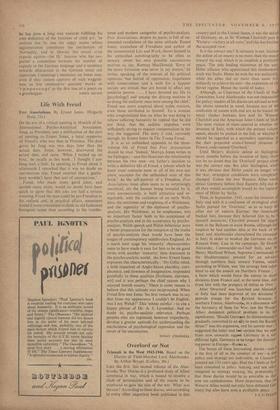Unbiography
The Magic-Maker : E.. E. Cummings. By Charles Norman. (Macmillan, New York, 41s.6d.)
E.. E CUMMINGS is . an important poet and the author of The Enbrmous Room, one of the best books to come out of America in.the Twenties. He rates, one concedes, a biography. Yet it seems a pity that one has to be written. Cummings' is a • reticent and elusive creature; his output has been small, much of it autobiographical and self• . explanatory; he began as no one's disciple, has ". ended as the master of no cult and has shunned the critical factions;,his life has been simply made, up of work and private affairs. Being a friend- of thirty-three years' standing; Mr. NorMan is not the man to invade the privacy of his subject, and so what we have is a formal and faceless monu- ment, with a wealth of factual inscription on the pedestal. One is reminded of the dull biography of Whitman that the poet—another elusive figure using 'I' as a mask—sanctioned before his death. The facts are here all right, recorded with devoted exactitude: 'Winter or summer, Cummings sketches the Square, quickly, skilfully; in a black- bound "Record" notebook of 180 lined and num- bered pages measuring seven by four and a quar- ter inches—Mr. Schwartz [the local stationer]. has named it in his honour "the Cummings size." ' But the features of the man are nowhere to be seen, except in the self-portrait on the frontispiece, which shows that Cummings is a tolerable painter, even if not 'one of the truly great creators of our time in paint.'
Mr. Norman is not much more illuminating about the magic than he is about the maker. Cummings's poetry is well worth analysis : the sublime and the silly are tantalisingly mixed. At his worst he is a Georgian in typographical fancy dress : the freak layout is usually a seduc- tion of the eye at the expense of the ear. less often a successful form of musical notation. Yet his best lyrics achieve the same sort of imme- diacy as the Zen painter sought, who used paper so thin that if he paused for thought the surface broke. His concern has been to shake up the pre- conceptions which the structure of language imposes on mind and heart and eye. By gram- matical sabotage--the transformation of ad- verbs and verbs into nouns and other devices--
he has gone a long way towards fulfilling his own definition of the function of child art : 'to undress one by one the soggy nouns whose agglomeration constitutes the Mechanism of .Normality, and to liberate the 'actual crisp organic squirm—the IS.' Anyone who has sus- pected a connection between the number of capitals in the German language and a tendency towards abstraction in the German mind can appreciate Cummings's insistence on lower case. even if they cannot approve of such waggiSh- ness as five consecutive question marks or `r-p-o-p-es-s-a-g-r' as the first line of a poem on







































 Previous page
Previous page